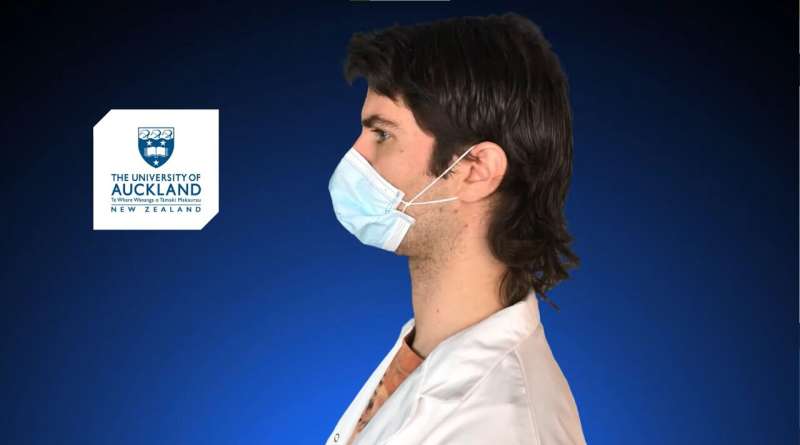'Knot and tuck' masks for better COVID protection

Experts are calling on the Ministry of Health to improve its mask wearing guidelines to ensure New Zealanders are protected in the wake of highly transmissible variants of COVID-19.
They say current mask practices at the border are sub-optimal for reducing the risk of aerosol transmission, and are calling for a public education campaign to help New Zealanders improve their mask use.
A new rapid evidence brief Improving mask use to stop COVID-19 transmission from Koi Tū: The Centre for Informed Futures at the University of Auckland, synthesizes the most up-to-date international research on the three main types of face masks—medical, cloth and N95 respirators. It provides suggestions for border workers, essential workers, and everyday New Zealanders.
The authors, Chloe Wilkinson, Dr. Felicia Low, Dr. Joel Rindelaub, and Koi Tū Director Sir Peter Gluckman, say N95 masks should be mandatory for MIQ workers, people staying in MIQ and all other personnel connected to border.
Sir Peter says: "Mask wearing is a critical part of our defense. Improving guidelines would seem prudent at the border while New Zealand continues to try and exclude the virus from entering the community, a strategy that is clearly required until vaccination rates are much higher."
Ministry of Health guidelines on mask use for managed isolation and quarantine facility staff were update in November 2020 and significantly strengthened in August 2021 after the emergence of the Delta variant. That update significantly extended the use of N95 respirators in MIQ although they did not make their use universal at the border.
Dr. Low says overseas, mask mandates have changed rapidly in response to rises and falls of case numbers. Several countries tightened mask requirements in response to the Delta variant.
"We need to ensure that those most likely to be exposed to the virus have the best possible protection, which would mean all essential and border workers should be wearing properly fitting N95 masks when on the job," she says.
Aerosol expert Dr. Rindelaub says a mask is only as good as its fit, so it is important to make sure that there are not any gaps between the face and mask when it is worn, especially along the nose or the sides of the face. Cloth masks need to be at least three layers of fabric, and bandanas and other face coverings aren't enough.
Medical masks were originally designed to protect against fluid splashes and other forms of droplet transmission, not the much smaller aerosols as found in the virus that spreads COVID-19.
Various laboratory tests suggest medical masks typically filter 50–75 percent of various test particles. Gaps around the face allow leakage of air, which significantly reduces mask effectiveness.
The effectiveness of medical masks can be greatly improved—filtering up to 60–90 percent of particles when modified to improve the seal against the face.
Dr. Rindelaub says one simple way to make medical masks more effective is to "knot and tuck," knotting the sides of the ear loops near the mask and tucking the pleats of the mask inwards. You can view his demonstration video here: youtu.be/m1yzpmqVF34
"Most people might not even realize that their mask isn't being worn correctly. If a mask doesn't fit properly, it will immediately lose much of its filtering power. Taking time to make sure your mask fits tightly could be the difference between getting sick and staying healthy," he says.
Suggested guidelines at all alert levels include:
For border and essential workers:
- All workers at the border are strongly recommended to wear certified N95 or similar respirator masks at all COVID-19 Alert Levels. This includes all managed isolation and quarantine facility staff, airport staff, and all other essential personnel.
- All individuals quarantining in managed isolation facilities are strongly recommended to wear certified N95 or similar respirator masks whenever they are outside their own rooms.
- Ideally no other types of masks should be used in these high-risk situations.
- All N95 respirator mask users should receive training on the optimal individual fit and use of these masks.
For the public:
- A public educational campaign emphasizing tight-fitting medical or three-layer cloth masks. It is essential that these fit snugly and seal well around facial contours, particularly across the nose and around the cheeks and chin.
- Medical masks should not be reused and should be replaced after being worn for a maximum of six hours. Instructions for modifying medical masks to improve the seal should be provided.
- Cloth masks should be made of at least three fabric layers and shaped to provide a snug seal against the face. Cloth masks with fewer layers, and loose face coverings such as bandannas and scarves, do not provide sufficient protection and should not be used.
- Cloth masks should be washed frequently (preferably daily) with soap and hot water, and dried thoroughly before being worn again.
- N95 and similar respirator masks should be prioritized for essential and border workers.
More information: Improving mask use to reduce COVID-19 transmission. informedfutures.org/improving-mask-use/





















